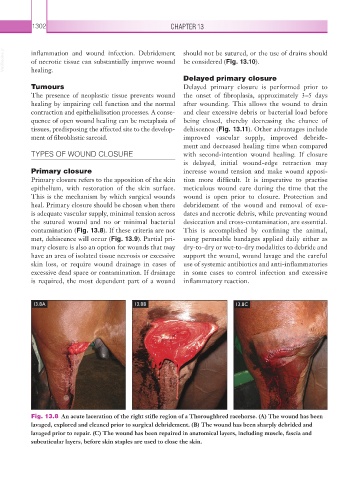Page 1327 - Equine Clinical Medicine, Surgery and Reproduction, 2nd Edition
P. 1327
1302 CHAPTER 13
VetBooks.ir inflammation and wound infection. Debridement should not be sutured, or the use of drains should
be considered (Fig. 13.10).
of necrotic tissue can substantially improve wound
healing.
Delayed primary closure
Tumours Delayed primary closure is performed prior to
The presence of neoplastic tissue prevents wound the onset of fibroplasia, approximately 3–5 days
healing by impairing cell function and the normal after wounding. This allows the wound to drain
contraction and epithelialisation processes. A conse- and clear excessive debris or bacterial load before
quence of open wound healing can be metaplasia of being closed, thereby decreasing the chance of
tissues, predisposing the affected site to the develop- dehiscence (Fig. 13.11). Other advantages include
ment of fibroblastic sarcoid. improved vascular supply, improved debride-
ment and decreased healing time when compared
TYPES OF WOUND CLOSURE with second-intention wound healing. If closure
is delayed, initial wound-edge retraction may
Primary closure increase wound tension and make wound apposi-
Primary closure refers to the apposition of the skin tion more difficult. It is imperative to practise
epithelium, with restoration of the skin surface. meticulous wound care during the time that the
This is the mechanism by which surgical wounds wound is open prior to closure. Protection and
heal. Primary closure should be chosen when there debridement of the wound and removal of exu-
is adequate vascular supply, minimal tension across dates and necrotic debris, while preventing wound
the sutured wound and no or minimal bacterial desiccation and cross-contamination, are essential.
contamination (Fig. 13.8). If these criteria are not This is accomplished by confining the animal,
met, dehiscence will occur (Fig. 13.9). Partial pri- using permeable bandages applied daily either as
mary closure is also an option for wounds that may dry-to-dry or wet-to-dry modalities to debride and
have an area of isolated tissue necrosis or excessive support the wound, wound lavage and the careful
skin loss, or require wound drainage in cases of use of systemic antibiotics and anti-inflammatories
excessive dead space or contamination. If drainage in some cases to control infection and excessive
is required, the most dependent part of a wound inflammatory reaction.
13.8A 13.8B 13.8C
Fig. 13.8 An acute laceration of the right stifle region of a Thoroughbred racehorse. (A) The wound has been
lavaged, explored and cleaned prior to surgical debridement. (B) The wound has been sharply debrided and
lavaged prior to repair. (C) The wound has been repaired in anatomical layers, including muscle, fascia and
subcuticular layers, before skin staples are used to close the skin.

